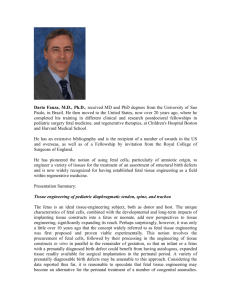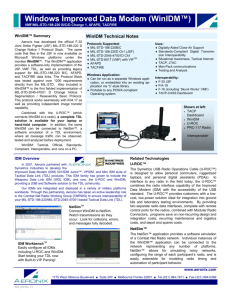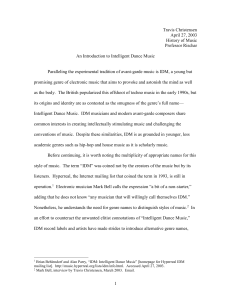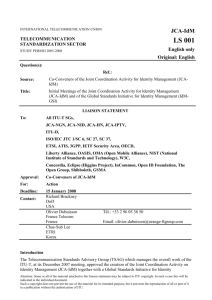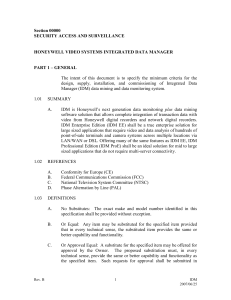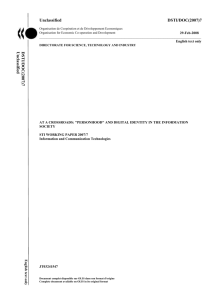Infant of a Diabetic Mother
advertisement
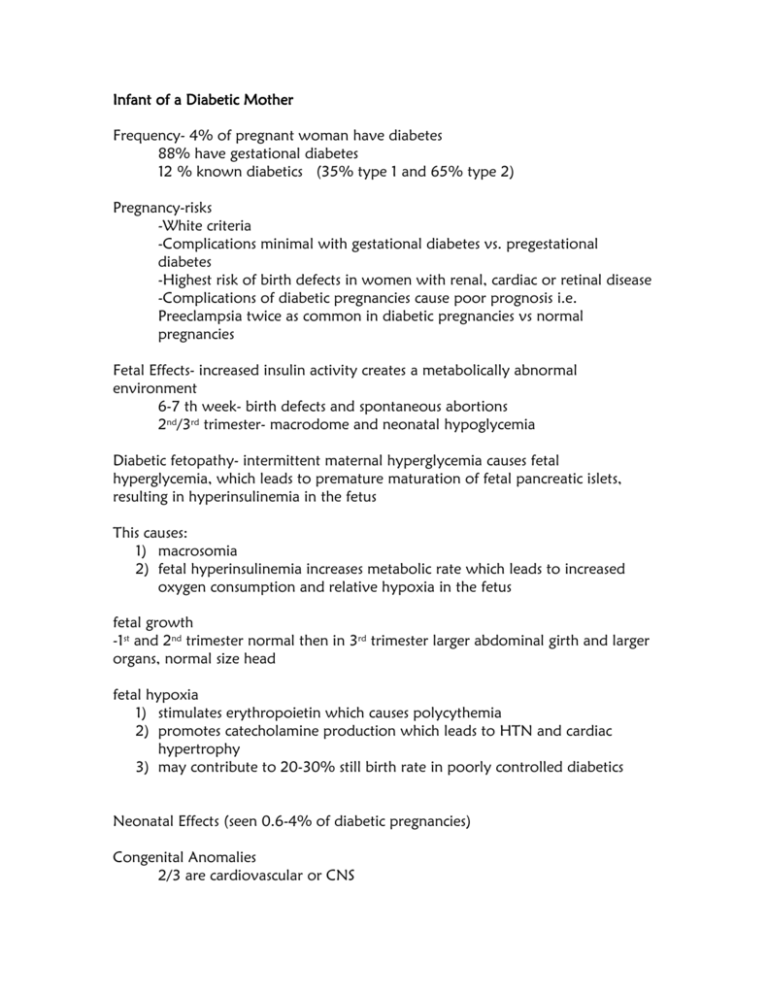
Infant of a Diabetic Mother Frequency- 4% of pregnant woman have diabetes 88% have gestational diabetes 12 % known diabetics (35% type 1 and 65% type 2) Pregnancy-risks -White criteria -Complications minimal with gestational diabetes vs. pregestational diabetes -Highest risk of birth defects in women with renal, cardiac or retinal disease -Complications of diabetic pregnancies cause poor prognosis i.e. Preeclampsia twice as common in diabetic pregnancies vs normal pregnancies Fetal Effects- increased insulin activity creates a metabolically abnormal environment 6-7 th week- birth defects and spontaneous abortions 2nd/3rd trimester- macrodome and neonatal hypoglycemia Diabetic fetopathy- intermittent maternal hyperglycemia causes fetal hyperglycemia, which leads to premature maturation of fetal pancreatic islets, resulting in hyperinsulinemia in the fetus This causes: 1) macrosomia 2) fetal hyperinsulinemia increases metabolic rate which leads to increased oxygen consumption and relative hypoxia in the fetus fetal growth -1st and 2nd trimester normal then in 3rd trimester larger abdominal girth and larger organs, normal size head fetal hypoxia 1) stimulates erythropoietin which causes polycythemia 2) promotes catecholamine production which leads to HTN and cardiac hypertrophy 3) may contribute to 20-30% still birth rate in poorly controlled diabetics Neonatal Effects (seen 0.6-4% of diabetic pregnancies) Congenital Anomalies 2/3 are cardiovascular or CNS anencephaly and spina bifida occur 12-20 more in IDMs than non-diabetic mothers common cardiac anomalies- transposition, VSD, coarc, ASD GI, GU and skeletal anomalies are also seen- specific to IDM’s is small left colon syndrome- inability to pass meconium that resolves spontaneously Caudal Regression Syndrome- (caudal agenesis, sacral dysgenesis or caudal dysplasia sequence) occurs 200 times more frequently in IDM than in regular pregnancy. Spectrum of structural defects of the caudal region- incomplete development of the sacrum and the lumbar vertebrae. Because of the involvement of the distal spine- neurological impairment is involved- ranging from incontinence to decreased growth and movement of the legs Premature Delivery- spontaneous premature labor occurs more frequently Perinatal Asphyxia- IDM are at higher risk for intrauterine or perinatal asphyxia (low fetal hr, low apgars and intrauterine death) Macrosomia- defined as >90% or >4000 grams. Typically appear large and plethoric, with excess fat accumulation in abdominal and scapular regions, and visceromegaly -predisposes to birth injury, shoulder dystocia, brachial plexus palsy, clavicular and humeral fractures, perinatal asphyxia and cephalohematoma IUGR- IDM can be IUGR if poorly controlled diabetic (class F) RDS- more frequent in infants of diabetic mom’s -delayed maturation of surfactant synthesis caused by hyperinsulinemia Other causes of Respiratory Distress-hypertrophic cardiomyopathy, and TTN Metabolic complications Hypoglycemia <40 mg/dl (27% of IDM have hypoglycemia) usually occurs in first few hours of life occurs because of persistent hyperinsulinemia Hypocalcemia <7mg/dl usually occurs in 24-72 hour of life thought to be due to low PTH in infant which may be due to increased maternal Ca during pregnancy usually asymptomatic and resolves on its own symptoms include- jitteriness, lethargy, apnea, tachypnea and seizures routine screen not recommended Hypomagnesemia <1.5mg/dl occurs in 40% of IDM transient and asymptomatic may need to treat if hypocalcemic Polycythemia and hyperviscosity Central crit>65 Occurs in 13-33% of IDM Related to hypoxia inutero Hyperviscsity- may lead to sludging and ischemia and infaction of internal organs Hyperbilirubinemia 11-29% in IDM thought to be due to increased hemolysis Cardiomyopathy Most are asymptomatic, but 5-10% have respiratory distress or signs of poor cardiac output or heart failure Usually transient but needs to be supported ECHO resolves in 6 months Thought to be due to fetal hyperinsulinemia, which increases synthesis and fat deposition in myocardial cells





